Heuchera care and growing guide – expert tips for stunning coral bells
Expert advice on growing easy-going heucheras for brilliant flowers and foliage
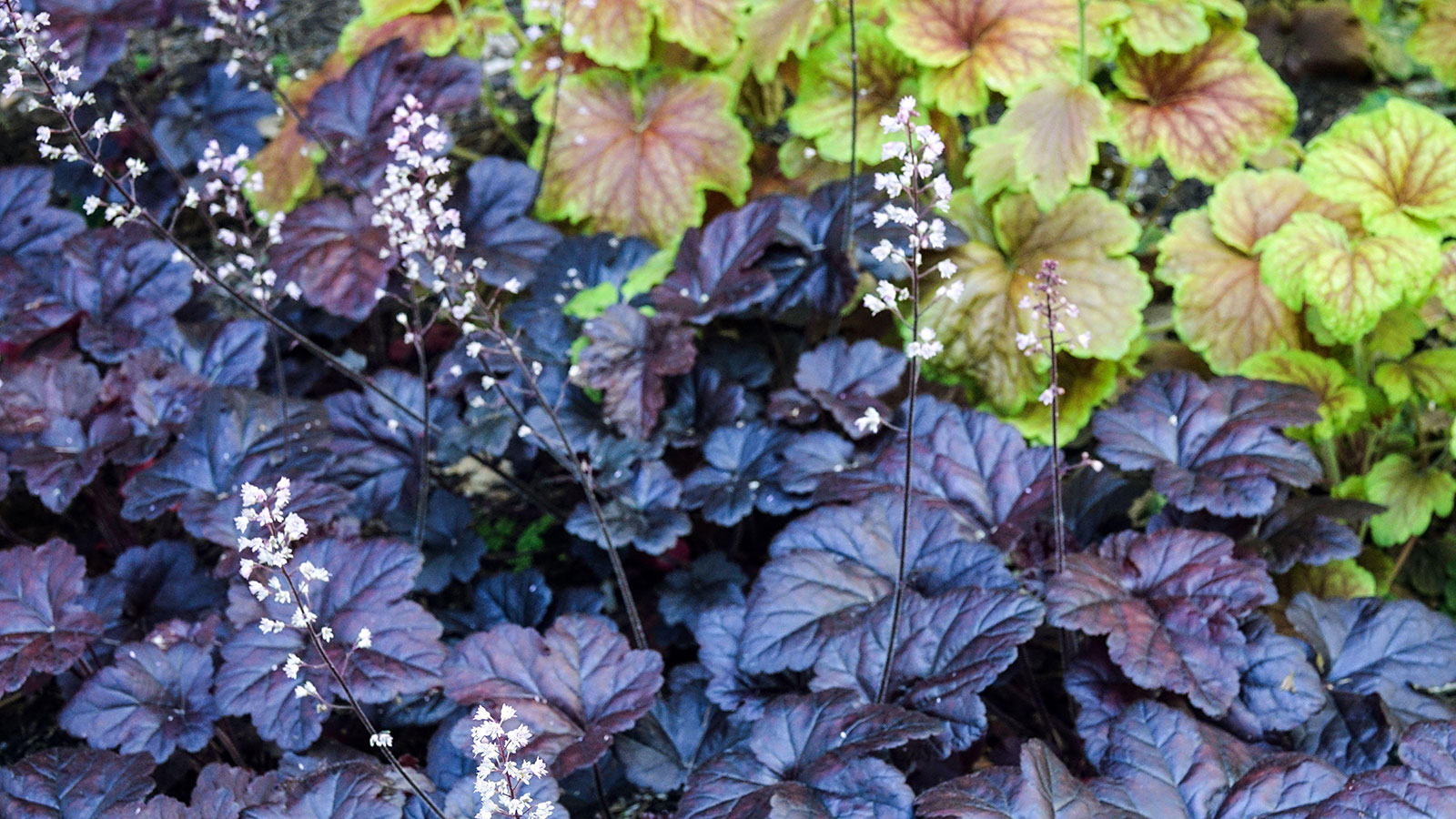

Graham Rice
Heucheras are some of the most beautiful and fascinating plants to grow in lightly shaded areas of your yard.
Also called coral root and coral bells, the best heuchera varieties are renowned for the vivid colors and patterns of their leaves, from acid green to orange, silver and deepest burgundy, and the slender stems of bell-shaped flowers that appear above them, usually in shades of pink, cream and white.
Heucheras are related to tiarellas, also known as foamflowers, and some breeders have hybridised the two and called them Heucherellas. These also come in many colours and are worth investigating.
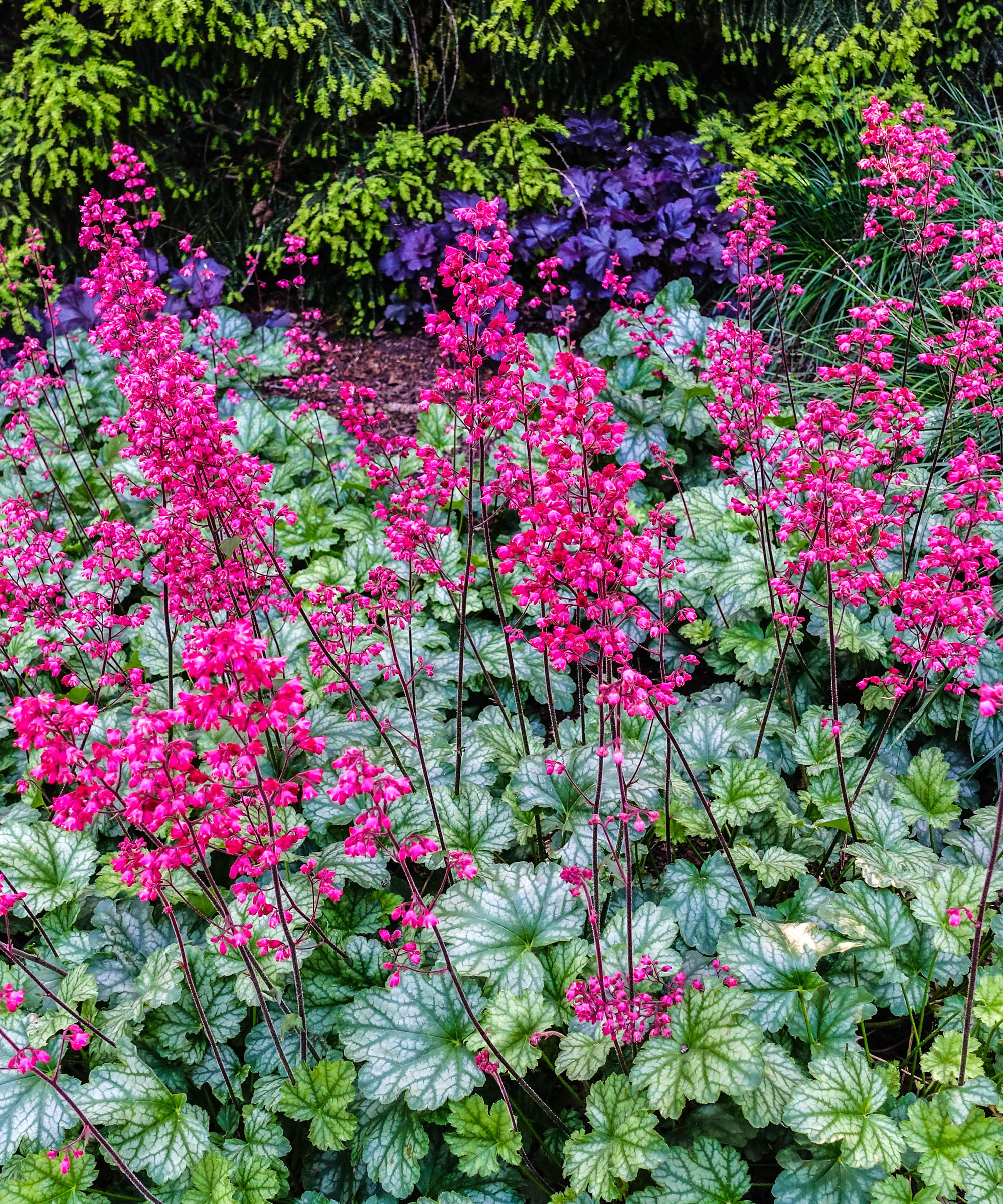
Heuchera 'Paris' is grown for its attractively marbled green leaves and tall stems of cerise flowers
Heucheras: key facts
- Ease of growing: Fairly easy to grow
- Plant type: Hardy perennial, evergreen in most zones
- Mature size: 10-30in
- Growth rate: Medium vigor
- Soil preference: Acid, neutral, slightly alkaline
- Best grown in: Part shade
- Time to plant: Early spring to early fall
- Peak season: Flowers spring, summer.
- Foliage: All year in most zones
- Hardiness zones: USDA Z4
- Scientific name: Heuchera
- Common name: Coral root, coral bells
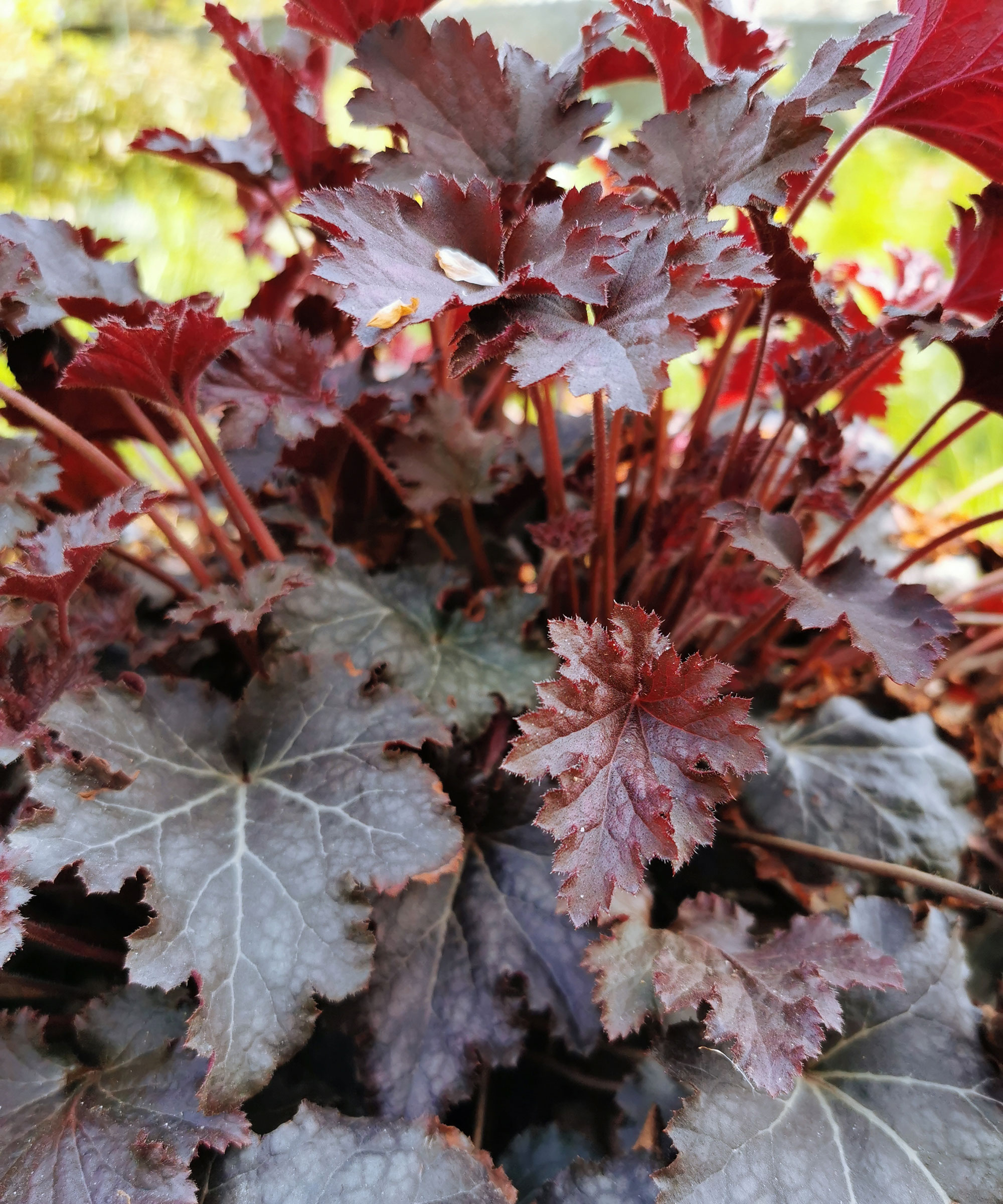
Heuchera 'Purple Palace' is a vintage variety still popular today
Where to grow heucheras
Heucheras grow best in rich but well-drained soil types or in a container of well-drained potting soil, such as Wonder Soil, available on Amazon.
They are perfect for a low-maintenance garden border, but they hate having 'wet feet' and will soon fade away in constantly damp ground.
So if your soil is heavy and holds water, either grow heucheras in planters or improve your soil and its drainage by adding lots of grit and well-rotted manure such as Wholly Cow on Amazon.
Neutral or slightly acid soil suits them best and they will usually take a little lime.
Because their leaves add color and interest for most of the year, heucheras are one of the best shade plants – though they prefer dappled sunlight and light shade to the deep shade found under a dense tree canopy.
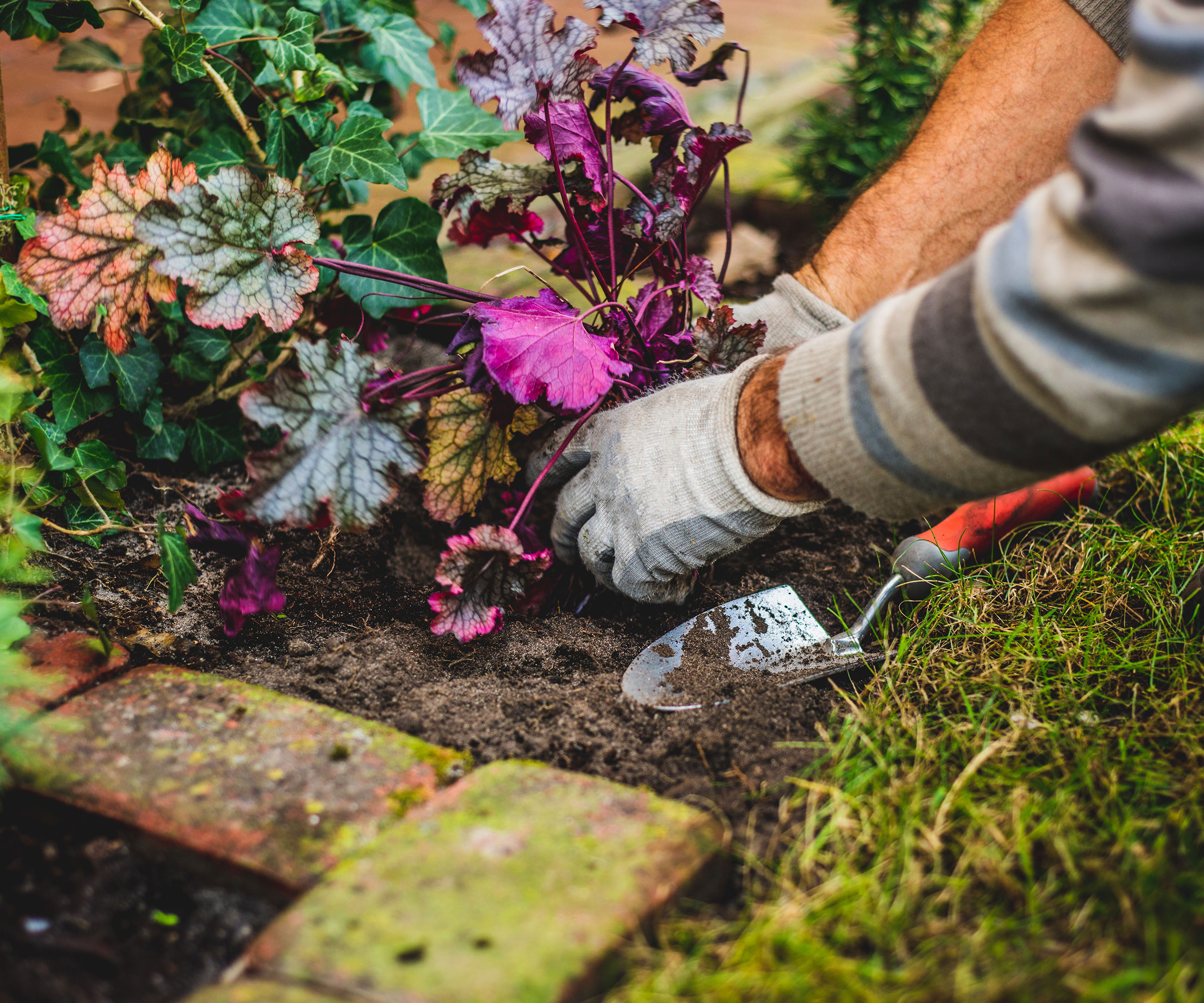
Plant your heuchera in sun or dappled shade in free-draining soil
When and how to plant heucheras
Heucheras should be planted between May and September in borders, containers or baskets (because they keep their leaves all year they work well in winter hanging basket ideas). They are also well worth including in ideas you may have for a living wall.
To plant in the soil, follow these simple instructions:
- Before planting, stand their pots in water for at least 30 minutes to give the roots a good soak. While they are sitting there, dig a hole that is the same depth as the plant's pot and just a little bit wider.
- Add a little fertilizer like Burpee Organic Plant Food or bone meal such as Espoma Organic Bone Meal, both on Amazon, to encourage good growth. Mix it with the soil at the bottom of the hole with a garden hand fork.
- Now carefully slide the heuchera from its pot and gently wiggle your thumbs into the rootball and tease out any roots that are growing around the rootball or look tightly tangled.
- Pop the plant in its hole and infill around the roots with the excavated soil, firming it down to support the plant and knock out air pockets. Water generously and keep the soil moist while your heuchera gets established
The same method applies when adding heucheras to a container or basket, though it is best to spread a gravel mulch over the top of the pot, such as this decorative grit topping on Amazon.
This looks attractive, helps conserve moisture in the potting soil and deters the common pest black vine weevils from laying eggs in the container.
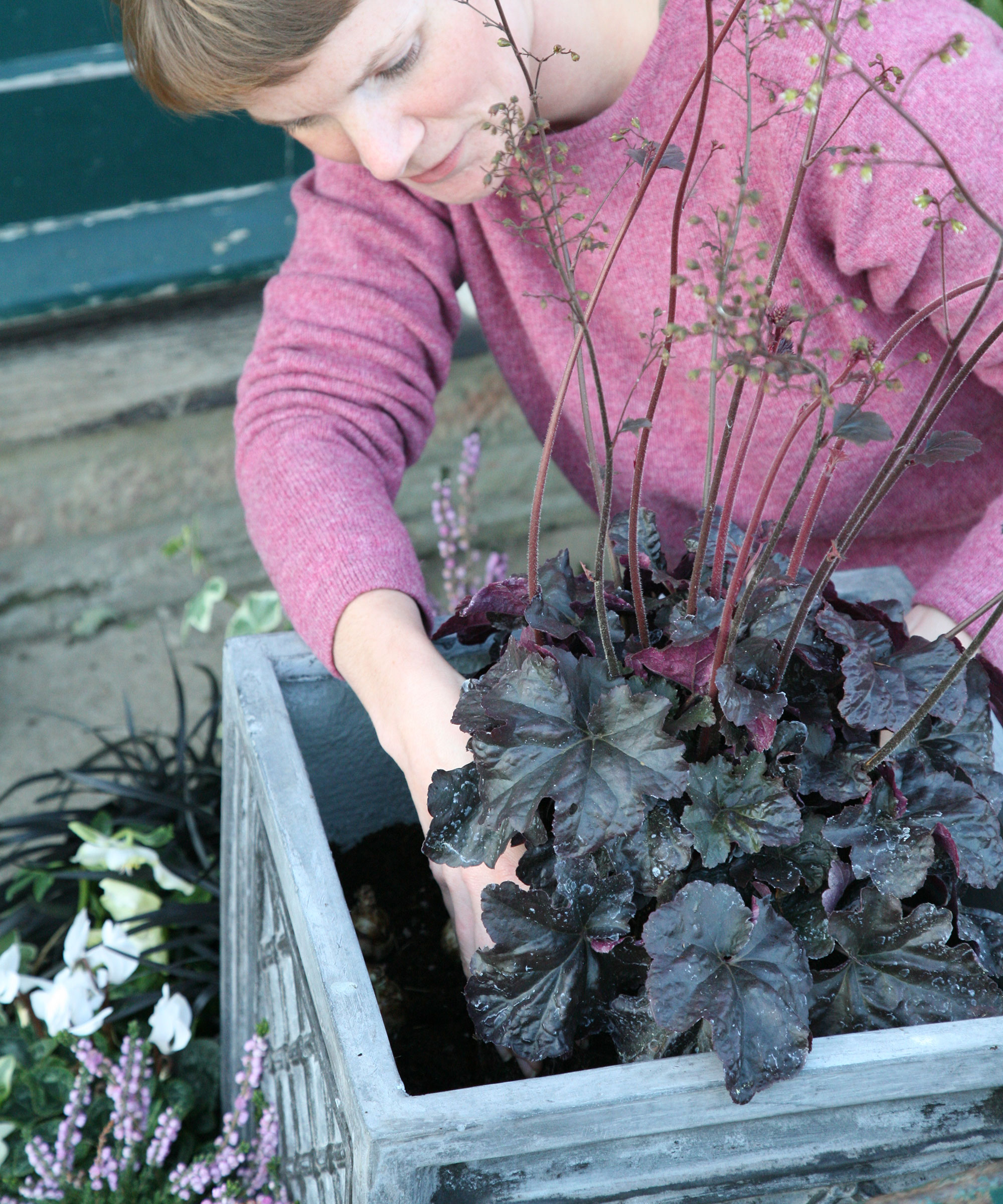
Heucheras look good in containers as part of a planting scheme or as a single statement plant
Care tips
Heucheras are pretty low-maintenance and need little aftercare once planted, apart from keeping their soil or potting compost damp while they settle in and deadheading their flowers as they fade.
Make sure you avoid one of the most common watering mistakes of getting moisture on heuchera leaves as this can cause fungal diseases and rotting. If this happens, cut off affected leaves before they spread disease to the rest of the plant. Once established, heucheras should only need watering during extended dry periods.
Freezing ground in winter can cause heucheras to suffer from a condition called 'frost heaving', when they are lifted from the ground by frost.
To prevent this happening, mulching with a weed-free organic mulch of composted manure, wood chip or bark chips around the plants in the fall will help insulate the soil.
As plants start to grow again in spring, feed with a general fertilizer such as Miracle Gro Shake n Feed available on Amazon. Water it into the soil or compost and mulch again with well-rotted farmyard manure or compost.
Varieties with small flowers should have them snipped off below the level of the foliage to improve their look. Then cut back all the top growth of coral bells in early spring to encourage fresh new growth.
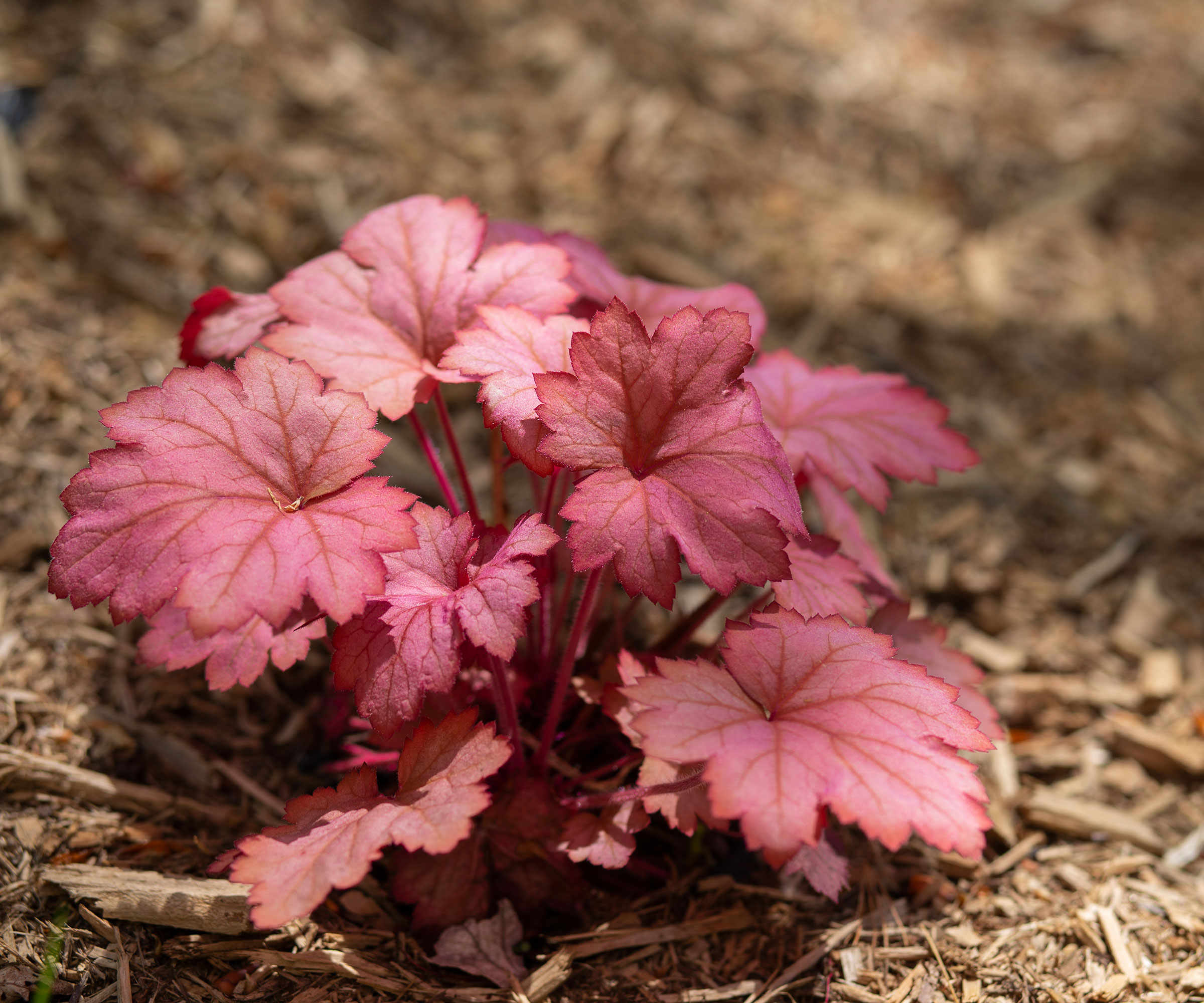
In fall, mulch heucheras with wood or bark chippings or well rotted manure or compost to prevent them being forced from the ground by frost
Propagating heucheras
Over time and as they mature, heucheras can develop woody centers that become unproductive and unsightly.
This can affect the plant's performance, and affects many varieties of perennial plants. The easiest way of curing the problem (and making more plants at the same time) is dividing plants in early spring. This is easy to do and the resulting plants will be identical to their parent.
- Dig up your large clump of heuchera and carefully pull or cut off a few healthy side shoots, making sure each piece has healthy leaves and roots.
- Plant up the divisions into small pots of nutrient-rich potting soil with added grit or perlite, like this coarse one by xGarden on Amazon, to help it drain freely.
- Place them somewhere warm but shaded and keep the compost damp as the divisions take root and start to grow.
- Discard the old, woody and unproductive part of the plant or use them as a useful woody ingredient in your homemade compost.
Another way of propagation is to remove the side crowns from mature plants in late summer and plant them in small containers of potting soil until they have grown large enough to be planted into the yard or a larger pot.
This may be later in the same year in warmer zones, or next spring if you live in a colder area. If this is the case, overwinter your young plants in your greenhouse, watering them sparingly.
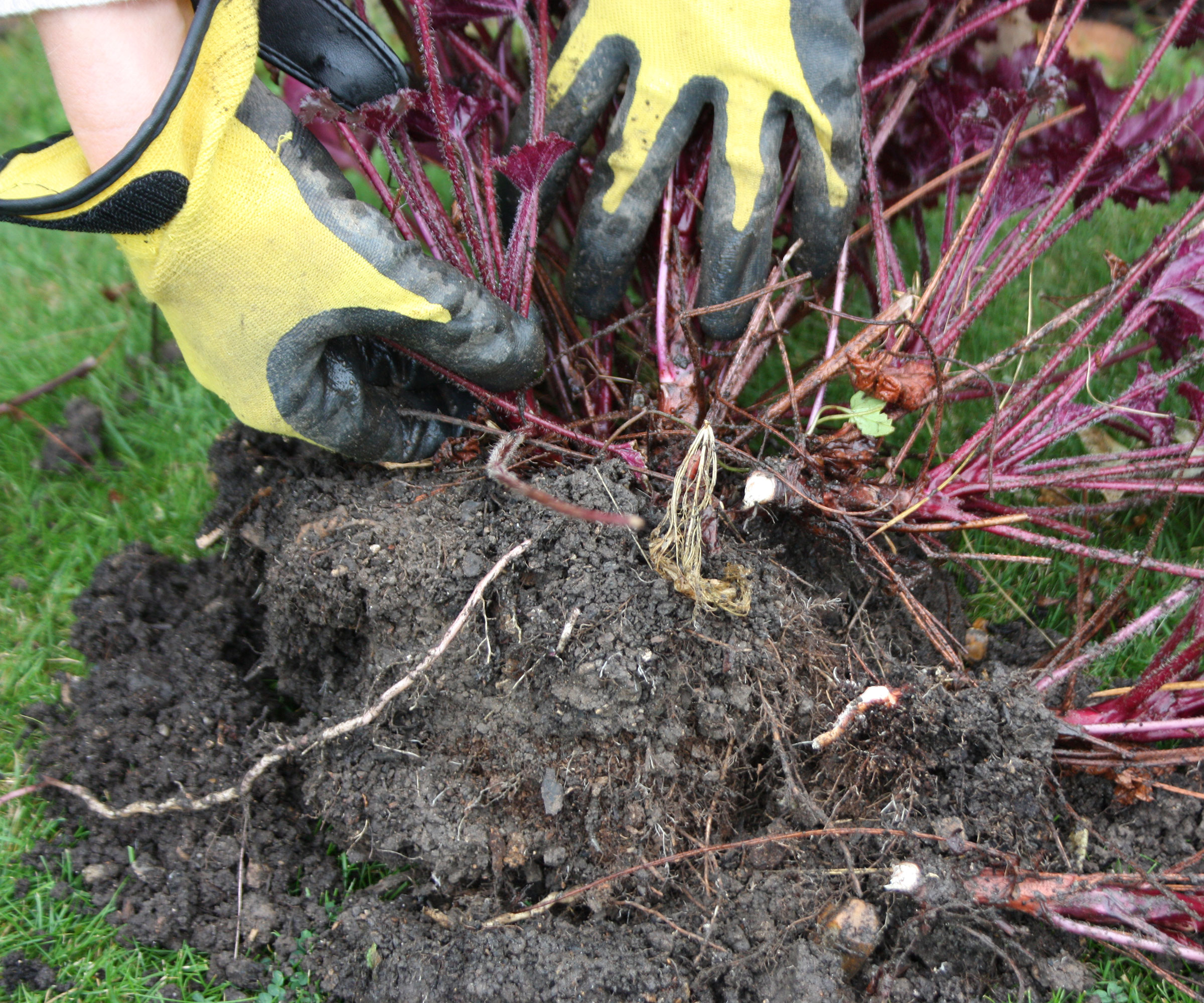
Divide older, unproductive clumps of heuchera by carefully pulling off side shoots and potting them up
Common heuchera problems and diseases
There are only a few things that will trouble your heucheras.
If they are planted in too sunny an area of your yard their leaves can scorch. If this turns out to be the case after planting, either dig them up and move them somewhere shadier or, if they are in a planter, move it out of full sun.
If you're growing your heucheras in a planter, grow them with other shade-loving container plants and avoid sun-lovers.
Another problem is the fungal disease heuchera rust, a common problem that shows as small brown spots on the top of the leaves and orange pustules underneath, which may turn grey in humid conditions.
You can help avoid heuchera rust by buying healthy plants and giving them plenty of space to grow, with good airflow around them. Remove, bin or burn any leaves immediately you spot signs of infection (never add diseased leaves to the compost heap), and water carefully to avoid wetting the foliage.
If the problem persists you may need to treat your heuchera with a fungicide spray such as this one Bonide spray on Amazon. Follow the manufacturer's instructions carefully and do not over-use.
Heuchera pests
The most common pest of heuchera is the black vine weevil, or taxus weevil, that advertises its presence by biting chunks out of the side of the leaves.
It is the small black adult insects that damage the leaves, and the damage is mainly cosmetic, but their grubs cause more serious problems.
The small, creamy C-shaped grubs, with distinctive orange heads, eat the roots so you can't see the damage being done. It is only when your heuchera inexplicably starts to wilt that you realise there is a problem – and by then it may be too late. In the worst cases, the entire crown of foliage comes away from the roots completely.
There are now organic, biological treatments that can solve the problem although often the first thing to do is dig up the infested plants, and the soil on the roots, and discard or burn.
If you prefer to go down the biological treatment route you can buy nematodes, such as these by BioLogic Scanmask on Amazon. A natural parasite of many pests, they are microscopic eelworms that are safe to use around pets and children and are watered onto the soil throughout the growing season.
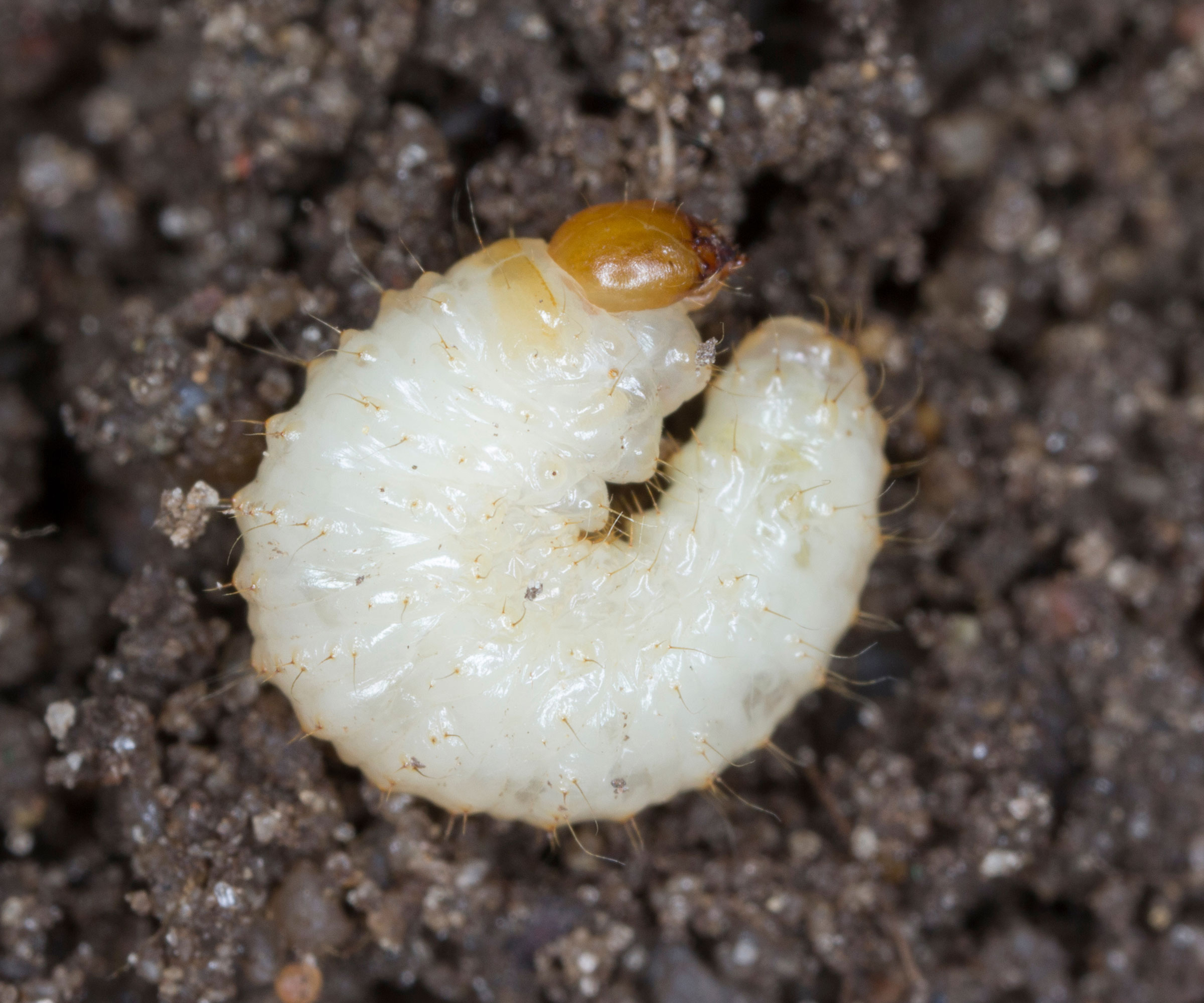
The larvae of black vine weevils do tremendous damage unseen under the soil
FAQs
Are heucheras deer resistant?
The experts at the New Jersey Agricultural Experiment Station at Rutgers University, have been researching deer resistance.
After extensive research they have assessed the resistance to deer browsing of many garden plants and have rated heucheras, coralbells, as Seldom Severely Damaged.
This is the second most deer resistant plants category so although there are plants which are rarely severely damaged, heucheras are left alone in most gardens.
Why is it suggested that heuchera flowers are sometimes cut off?
Many heuchera varieties produce flowers carried above the leaves on upright stems. Often these flowers are small and insignificant and have little appeal, although they are popular with pollinators, and simply distract attention from the appeal of the many foliage colors and patterns.
That is why it is often recommended that the flowers be snipped off when still in bud. It is important to snip them off carefully, below the level of the leaves, so that the remains of the stems are hidden.
Because the stems are slim and require careful cutting, you might find it easiest to use a pair of narrow-bladed garden snips, like this small pair by Vivosun on Amazon.
Some varieties, however, have larger and more colorful flowers and these should be left uncut.
My heuchera seems to be slowly rising out of the ground, showing its woody stem. What should I do?
This is not unusual, but it detracts from the look of the plant and is a sign that attention is needed.
The simplest approach is to dig up the whole plant in spring, or late summer, improve the spoil and then replant with those bare woody stems below soil level. They will produce roots and a large new plant will be the result.
Better, is to divide the plant into pieces – each with both leaves and roots. These can be replanted in the same site, or elsewhere.
Finally, you can also snip off individual side crowns and either replant them straight away – most should root – or grow them on in pots for few months in a sheltered place.
Heucheras live for many years and because of the strongly colored foliage are excellent companions for many plants. Those with purple leaves look wonderful paired with the best tropical garden varieties such as canna lilies, and their spreading habit makes them excellent as ground cover plants.
Their bold colors are also suitable for a shaded gravel garden and contemporary planting schemes.
Sign up to the Homes & Gardens newsletter
Design expertise in your inbox – from inspiring decorating ideas and beautiful celebrity homes to practical gardening advice and shopping round-ups.

Ruth is a Contributing Editor for Homes & Gardens, and formerly Gardening Editor of Amateur Gardening magazine. She is horticulturally trained, with a qualification from the Royal Horticultural Society. Her work for Amateur Gardening, the world's oldest weekly gardening publication, involved matching gardening tasks with each season, covering everything from sowing and planting, to pruning, taking cuttings, dealing with pests and diseases and keeping houseplants healthy. She is an expert in ornamental plants and edible crops, and everything she writes about and photographs is in her own garden, that has been a work in progress since her family moved there in 2012.
- Graham RiceFreelance writer
-
 I always get my small space storage from Wayfair – and these discounted $35 stackable Martha Stewart storage boxes are the perfect fix for my tiny vanity
I always get my small space storage from Wayfair – and these discounted $35 stackable Martha Stewart storage boxes are the perfect fix for my tiny vanityI'm going vertical for tiny space storage success with this Early Way Day 2025 bargain
By Punteha van Terheyden
-
 These are the colors that just don't work with purple – 4 shades to sheer clear of if you want to bring this on trend color into your home
These are the colors that just don't work with purple – 4 shades to sheer clear of if you want to bring this on trend color into your homeWhy some colors sabotage purple, and how to get it right every time.
By Sophia Pouget de St Victor